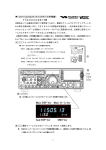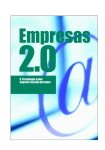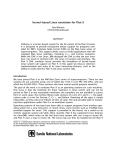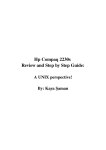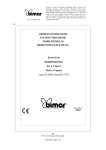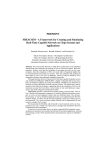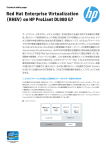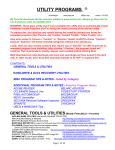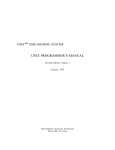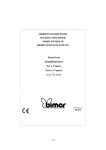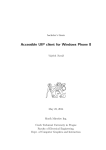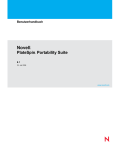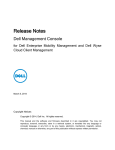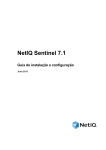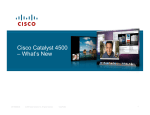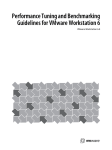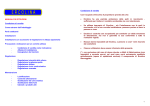Download Comparison of application virtual machines
Transcript
Topic relevant selected content from the highest rated entries, typeset, printed and shipped. Combine the advantages of up-to-date and in-depth knowledge with the convenience of printed books. A portion of the proceeds of each book will be donated to the Wikimedia Foundation to support their mission: to empower and engage people around the world to collect and develop educational content under a free license or in the public domain, and to disseminate it effectively and globally. The content within this book was generated collaboratively by volunteers. Please be advised that nothing found here has necessarily been reviewed by people with the expertise required to provide you with complete, accurate or reliable information. Some information in this book maybe misleading or simply wrong. The publisher does not guarantee the validity of the information found here. If you need specific advice (for example, medical, legal, financial, or risk management) please seek a professional who is licensed or knowledgeable in that area. Sources, licenses and contributors of the articles and images are listed in the section entitled “References”. Parts of the books may be licensed under the GNU Free Documentation License. A copy of this license is included in the section entitled “GNU Free Documentation License” All used third-party trademarks belong to their respective owners. Contents Articles Comparison of application virtual machines 1 Comparison of platform virtual machines 6 Comparison of VMware Fusion and Parallels Desktop 20 Adaptive Domain Environment for Operating Systems 29 ALGOL 68C 30 Amazon Machine Image 33 Application virtualization 34 ARMware 36 Byte Code Engineering Library 37 Bytecode 38 CherryOS 40 CHIP-8 42 chroot 46 Computer cluster in virtual machines 48 Cooperative Linux 51 Copy-on-write 54 CP-370 55 CP-67 56 CP/CMS 57 Denali (operating system) 63 Dynamic Logical Partitioning 63 Workload Partitions 64 Dynamic recompilation 65 EasyVZ 68 Egenera 69 Embedded hypervisor 72 Ericom Software 76 Full system simulator 79 Full virtualization 80 HiperSocket 81 History of CP/CMS 82 HP Integrity Virtual Machines 93 Hyper-V 96 Hypervisor 103 HyperVM 108 I/O virtualization 110 IBM CP-40 112 IBM M44/44X 117 IBM OLIVER (CICS interactive test/debug) 118 IBM WebSphere eXtreme Scale 122 iCore Virtual Accounts 124 iEmulator 125 InstallFree 126 Kernel-based Virtual Machine 129 Lanamark 132 libquantum 133 Live migration 133 LivePC 134 Logical Domains 135 Logical partition (virtual computing platform) 137 Mac-on-Linux 140 Mac-on-Mac 141 Marionnet 142 Memory virtualization 145 Merge (software) 148 Microsoft App-V 149 Windows Virtual PC 154 Microsoft Virtual Server 168 MojoPac 170 MokaFive 172 Network virtualization 176 Novell ZENworks Application VIrtualization 178 Open Kernel Labs 180 Open Virtualization Alliance 182 Open Virtualization Format 182 Operating system-level virtualization 184 Optimal IdM 187 Oracle Enterprise Manager Ops Center 189 Oracle VM 190 OVPsim 191 Pano Logic 194 Parallels Desktop for Mac 197 Parallels Server for Mac 205 Parallels Virtual Desktop Infrastructure 208 Parallels Workstation 210 Parallels Workstation Extreme 212 Parallels, Inc. 214 Paravirtualization 217 Partial virtualization 219 PearPC 223 Physical-to-Virtual 225 PikeOS 227 PlateSpin 229 Popek and Goldberg virtualization requirements 230 PowerVM 235 PowerVM Lx86 237 PR/SM 238 Q (emulator) 239 Quantum virtual machine 240 QuickTransit 241 Qumranet 242 R1soft Hyper-V VHD Explorer 243 Rawdisk 244 RingCube vDesk 245 Sandbox (computer security) 246 Sandbox (software development) 247 Simics 248 SIMNET 249 SIMON (Batch Interactive test/debug) 252 Software Virtualization Solution 253 SoftXpand 254 Solaris Containers 254 SPECvirt 257 Storage virtualization 258 Sun xVM 266 SVISTA 267 SWsoft 269 Sysjail 273 Systancia 274 Timeline of virtualization development 275 Tvpc 282 TwoOStwo 282 UC4 284 Virtual 8086 mode 285 Virtual appliance 286 Virtual Application 288 Virtual backup appliance 288 Virtual disk image 289 Virtual DOS machine 294 Virtual file system 296 Virtual Iron 300 Virtual lab automation 301 Virtual Machine lifecycle management 304 Virtual Machine Manager 306 Virtual Processor 307 Virtual resource partitioning 308 Virtual security appliance 309 Virtual security switch 311 VirtualBox 314 Virtualization engine 320 VM (operating system) 321 VM-CP 328 VM/XA 329 VM2000 335 VMmark 336 VMQ 337 VMware Fusion 338 VMware Infrastructure 343 VMware Player 345 VMware ThinApp 347 VMware VMFS 349 VMware vSphere 351 VMware Workstation 353 Vx32 359 Wanova 360 Win4Lin 363 x86 virtualization 364 XenClient 368 XenMan 369 Xenocode 370 z/VM 372 Zinstall XP7 376 References Article Sources and Contributors 378 Image Sources, Licenses and Contributors 385 Article Licenses License 387 Comparison of application virtual machines 1 Comparison of application virtual machines This article lists some software virtual machines that are typically used for allowing application bytecode to be portably run on many different computer architectures and operating systems. The application is usually run on the computer using an interpreter or just-in-time compilation. There are often many implementations of a given virtual machine, each covering a different functionality footprint. Comparison of virtual machines The table here summarizes elements for which the virtual machine designs intended to be efficient, not the list of capabilities present in any implementation. Virtual machine Machine model Memory management stack automatic or manual Dis (Inferno) register automatic DotGNU Portable.NET stack automatic or manual JVM stack automatic JikesRVM stack automatic LLVM register manual Mono stack automatic or manual Parrot register automatic Dalvik register automatic libJIT stack manual Squeak stack automatic CLR Code security Interpreter JIT Precompilation Yes No Yes Yes No No Yes Yes No No No Yes Yes Yes No Yes Yes Yes No No No Yes Yes Yes Yes Yes Yes Yes Yes Yes Shared libraries Common Language Object Model Dynamic typing Yes Yes Yes Yes Yes Yes No No Yes Yes Yes No Yes Yes Yes No No No No Yes Yes Yes No Yes Yes Yes Yes No Yes Yes Yes No No Yes ? Yes Yes ? ? No No source to bytecode Yes ? No No Yes Virtual machine instructions process data in local variables using a main model of computation, typically that of a stack machine, register machine, or random access machine often called the memory machine. Use of these three techniques is motivated by different tradeoffs in virtual machines vs physical machines, such as ease of interpretation, compilation, and verifiability for security. Memory management in these portable virtual machines is addressed at a higher level of abstraction than in physical machines. Some virtual machines, such as the popular JVM, are involved with addresses in such a way as to require safe automatic memory management by allowing the virtual machine to trace pointer references, and disallow machine instructions from manually constructing pointers to memory. Other virtual machines, such as LLVM, are more like traditional physical machines, allowing direct use and manipulation of pointers. CIL offers a hybrid in between, offering both controlled use of memory (like the JVM, which allows safe automatic memory Comparison of application virtual machines management), while also offering an 'unsafe' mode that allows direct manipulation of pointers in ways that can violate type boundaries and permission. Code security generally refers to the ability of the portable virtual machine to run code while only offering it a prescribed set of capabilities. For example, the virtual machine might only allow the code access to a certain set of functions or data. The same controls over pointers which make automatic memory management possible and allow the virtual machine to ensure typesafe data access are used to assure that a code fragment is only allowed to certain elements of memory and cannot sidestep the virtual machine itself. Other security mechanisms are then layered on top as code verifiers, stack verifiers, and other techniques. An interpreter allows programs made of virtual instructions to be loaded and immediately run without a potentially costly compilation into native machine instructions. Any virtual machine which can be run can be interpreted, so the column designation here refers to whether the design includes provisions for efficient interpretation (for common usage). Just-in-time compilation or JIT, refers to a method of compiling to native instructions at the latest possible time, usually immediately before or during the running of the program. The challenge of JIT is more one of implementation than of virtual machine design, however, modern designs have begun to make considerations to help efficiency. The simplest JIT techniques simply perform compilation to a code-fragment similar to an offline compiler. However, more complicated techniques are often employed, which specialize compiled code-fragments to parameters that are known only at runtime (see Adaptive optimization). Precompiling refers to the more classical technique of using an offline compiler to generate a set of native instructions which do not change during the runtime of the program. Because aggressive compilation and optimization can take time, a precompiled program may launch faster than one which relies on JIT alone for execution. JVM implementations have mitigated this startup cost by using interpretation initially to speed launch times, until native code-fragments can be generated through JIT. Shared libraries are a facility to reuse segments of native code across multiple running programs. In modern operating systems, this generally means using virtual memory to share the memory pages containing a shared library across different processes which are protected from each other via memory protection. It is interesting that aggressive JIT techniques such as adaptive optimization often produce code-fragments unsuitable for sharing across processes or successive runs of the program, requiring a tradeoff be made between the efficiencies of precompiled and shared code and the advantages of adaptively specialized code. For example, several design provisions of CIL are present to allow for efficient shared libraries, possibly at the cost of more specialized JIT code. The JVM implementation on Mac OS X uses a Java Shared Archive (apple docs [1]) to provide some of the benefits of shared libraries. List of application virtual machine implementations In addition to the portable virtual machines described above, virtual machines are often used as an execution model for individual scripting languages, usually by an interpreter. This table lists specific virtual machine implementations, both of the above portable virtual machines, and of scripting language virtual machines. 2 Comparison of application virtual machines Virtual machine Languages 3 Comments JIT Implementation Language Interpreter Adobe Flash Player (aka Tamarin) ActionScript, SWF (file format) interactive web authoring tool. bytecode is named "ActionScript Byte Code (.abc)" Yes Yes BEAM Erlang, Reia, Lisp Flavoured Erlang There exists a native-code compiler, HiPE. Yes No Clipper, Harbour plankton, HVM Yes No Limbo Dis Virtual Machine [2] Specification Yes Yes Clone of Common Language Runtime No Yes Clipper p-code Dis (Inferno) DotGNU/Portable.NET CLI languages including: C# Forth Forth Features are simplified, usually include assembler, compiler, text-level and binary-level interpreters, sometimes editor, debugger and OS. Compilation speeds are >20 SKLOC/S and behave much like JIT. Glulx Glulx, Z-code Icon Icon JVM Java, Groovy, JRuby, C, C++, Clojure, Scala and [3] several others Reference [4] implementation by Sun ; OpenJDK: code under GPL ; IcedTea: code and tools under GPL C, C++, Objective-C, Ada, and Fortran MSIL, C and C++ output are supported. ActionScript Byte Code output is supported by Adobe Alchemy. bytecode is named "LLVM Bytecode (.bc)". assembly is named "LLVM Assembly Language (*.ll)". LLVM Lua Lua MMIX MMIXAL Mono CLI languages clone of Common including: C#, Language Runtime. VB.NET, IronPython, IronRuby, and others C++ 135k (initially released) C 247k C C Yes Yes 15k + 2850 per JIT arch + 500 per host OS C, C# Forth, Forth Assembler 2.8K to 5.6K; advanced, professional implementations are smaller. JDK, OpenJDK & IcedTea with regular JIT : Java, C, ASM ; IcedTea with the "Zero" JIT : Java, C JVM is around 6500k lines; TCK is 80k tests and around 1000k lines No Yes SLoC C++ Yes Yes Yes Yes LuaJIT [5] Yes C 13k + 7k LuaJIT C#, C 2332k Comparison of application virtual machines Oz NekoVM Oz, Alice currently Neko and haXe O-code machine BCPL p-code machine Pascal Parrot Perl virtual machine CPython 4 Yes C 46k C, Perl 111k C, 240k Perl C, Perl 175k C, 9k Perl C 387k C, 368k Python, 10k ASM, 31k Psyco UCSD Pascal, widespread in late 70s including Apple II Perl (6 & 5), NQP-rx, PIR, PASM, PBC, BASIC, bc, C, ECMAScript, Lisp, Lua, m4, Tcl, WMLScript, XML, and others Perl x86 only op-code tree walker Yes Yes Yes No Python Psyco Yes PyPy Rubinius SEAM ScummVM SECD Python Ruby Yes Yes Virtual machine for another Ruby implementation Yes Yes Scumm Computer game engine ISWIM, Lispkit Lisp Squirrel Smalltalk Smalltalk Yes SQLite SQLite opcodes Virtual database engine Squeak Squeak Smalltalk Self hosting implementation of Squeak virtual machine. Rich multi-media support. TraceMonkey Translator Engine C++, Ruby Alice Squirrel TaoGroup VP/VP2 Python Self-hosting implementation of Python, next generation of Psyco C, Java Proprietary embedded VM JavaScript Based on Tamarin Squirrel_JIT C++ Smalltalk/Slang Yes Cog[6] & Exupery No Yes C++ Yes No C (typically) Flat File IDE, programming by Tables/Global C++ demonstration variable declarations TrueType TrueType Font rendering engine Valgrind x86/x86-64 binaries Checking of memory accesses and leaks under Linux 12k [7] 110k Smalltalk, ~300K C 173k Comparison of application virtual machines VisualWorks VMKit 5 Smalltalk [8] JVM and CLI virtual machine based on LLVM. Vx32 virtual machine Application-level virtualization for native code Waba Virtual machine for small devices, similar to Java Yet Another Ruby VM (YARV) Z-machine Zend Engine libJIT Library for Just-In-Time compilation Ruby No Yes No Yes Yes No C Virtual machine of the reference implementation for Ruby 1.9 and newer versions Z-Code PHP Common Intermediate Language Java bytecode Domain-specific programming language Virtual machine is used in Portable.NET Just-In-Time compiler, ILDJIT, HornetsEye Yes Yes C 75k C, ia32, arm, amd64, alpha, low-level CPU architecture specific machine code References [1] [2] [3] [4] [5] [6] [7] [8] http:/ / developer. apple. com/ mac/ library/ documentation/ Java/ Conceptual/ Java14Development/ 00-Intro/ JavaDevelopment. html http:/ / doc. cat-v. org/ inferno/ 4th_edition/ dis_VM_specification http:/ / www. is-research. de/ info/ vmlanguages/ http:/ / java. sun. com/ javase/ http:/ / luajit. org/ http:/ / www. mirandabanda. org/ cog/ http:/ / wiki. squeak. org/ squeak/ 2267 http:/ / vmkit. llvm. org/ • "libJIT vs LLVM discussion" Rhys Weatherley (libJIT) and Chris Lattner (LLVM) (http://lists.gnu.org/ archive/html/dotgnu-libjit/2004-05/index.html) External links • List of Java Virtual Machines (JVMs), Java Development Kits (JDKs), Java Runtime Environments (JREs) (http:/ /java-virtual-machine.net/other.html) Comparison of platform virtual machines 6 Comparison of platform virtual machines Platform virtual machines are software packages which emulate the whole physical computer machine, often giving multiple virtual machines on one physical platform. The table below compares basic information about platform virtual machine (VM) packages. General information Name Creator Host CPU Guest CPU Host OS(s) Guest OS(s) License Bochs Kevin Lawton Any x86, x86-64 Linux, IRIX, AIX, FreeBSD, OpenBSD, BeOS, Mac OS X DOS, Windows, Windows Mobile, xBSD, Linux, OS/2 LGPL Solaris 10, Solaris 11 Express, OpenSolaris 2009.06 Solaris (8, 9, 10, 11), Linux (BrandZ) Same as host Windows 2000, XP, 2003, [1] Vista Linux Denali Ilwaco, NetBSD Containers, or Zones Sun Microsystems x86, x86-64, SPARC (portable: not tied to hardware) [1] Same as host Cooperative Linux Dan Aloni, other developers (1) Denali University of Washington x86 x86 DOSBox Peter Veenstra, Sjoerd, community help Any x86 x86 CDDL Linux, Internally emulated Windows, Mac DOS shell; classic OS classic, Mac PC booter games, OS X, BeOS, unofficially Windows FreeBSD, 1.0 to 3.11 OpenBSD, Solaris, QNX, IRIX, MorphOS, AmigaOS, Maemo DOSEMU Community project x86, x86-64 x86 Linux DOS FreeBSD Jail FreeBSD Any running FreeBSD Any running FreeBSD FreeBSD FreeBSD, Linux ABI GXemul Anders Gavare Any ARM, MIPS, M88K, PowerPC, SuperH Unix-like NetBSD, OpenBSD, Linux, Ultrix, Sprite Hercules Begun by Roger Bowler, as of 2011 maintained by Jay Maynard Any z/Architecture Unix-like Linux on zSeries, z/OS, z/VM, z/VSE, OS/360, DOS/360, DOS/VS, MVS, VM/370, TSS/370 GPL version 2 ? GPL GPL version 2 BSD BSD QPL Comparison of platform virtual machines Hyper-V Server 2008 R2 Microsoft 7 x86-64 + hardware-assisted virtualization (Intel VT-x or AMD-V) x86-64, x86 (up to 8 physical CPUs) Windows 2008 supported drivers for w/Hyper-V Role, Windows 2000, Windows Windows 2003, Hyper-V Server Windows 2008, Windows XP, Windows Vista, Linux (SUSE 10 released, more announced) iCore Virtual Accounts iCore Software x86 x86 Windows XP Windows XP Integrity Virtual Machines Hewlett-Packard IA-64 IA-64 HP-UX HP-UX, Windows, Linux (OpenVMS announced) JPC (Virtual Machine) Oxford University Any running the Java Virtual Machine x86 Java Virtual Machine DOS, Linux, Windows up to 3.0 KVM Qumranet [2] x86, x86-64, IA-64, with x86 virtualization, s390, PowerPC (see restrictions, e.g., no PowerPC 970 [3] support ) Same as host Linux FreeBSD, Linux, Solaris, Windows Linux-VServer Community Project x86, x86-64, IA-64, Alpha, PowerPC 64, PA-RISC 64, SPARC64, ARM, S/390, SH/66, MIPS Compatible LynxSecure lxc Mac-on-Linux Mac-on-Mac OpenVZ LynuxWorks x86, Intel VT-x, Intel VT-d [5] Sebastian Gregorzyk Proprietary GPL version 2 GPL version 2 Linux Linux variants GPL version 2 No host OS LynxOS, Linux, Windows Same as host Linux Linux variants PowerPC PowerPC Linux Mac OS X, Mac OS 7.5.2 to 9.2.2, Linux GPL PowerPC PowerPC Mac OS X, up to Tiger excluded Mac OS X, Mac OS 7.5.2 to 9.2.2, Linux GPL Same as host Linux Linux variants Community project, x86, x86-64, IA-64, supported by PowerPC 64, SWsoft, now SPARC64 Parallels, Inc. Proprietary GPL version 2 GPL Oracle VM for Oracle Corporation x86 x86, x86-64, Intel VT-x, AMD-V x86, x86-64, Intel VT-x, AMD-V No host OS Microsoft Windows, Oracle Enterprise Linux, Red Hat Enterprise Linux, Solaris Oracle Corporation UltraSPARC T1, UltraSPARC T2, UltraSPARC T2+, SPARC T3 Compatible Solaris 10 Solaris, Linux, FreeBSD Oracle VM Server for SPARC (LDoms) Proprietary x86 Community project x86, x86-64, IA-64, PowerPC 64, lxc.sourceforge.net [4] SPARC64 Mac-on-Linux Proprietary Oracle VM Server GPL; Manager proprietary Proprietary Comparison of platform virtual machines OVPsim OVP [6] Parallels Desktop for Mac Parallels, Inc. Parallels Workstation Parallels, Inc. PearPC Sebastian Biallas PikeOS PowerVM QEMU SYSGO AG IBM Fabrice Bellard, other developers 8 x86 x86, Intel VT-x x86, Intel VT-x OR1K, MIPS32, ARC600/700, ARM; and public API which enables users to write custom processor models, RISC, CISC, DSP, VLIW all possible x86 x86 x86, x86-64, PowerPC PowerPC PowerPC, x86, ARM, MIPS, SPARC, SuperH Same as host POWER4, POWER5, POWER6, PowerPC 970 POWER4/5/6, PowerPC 970, X86 (PowerVM-Lx86) x86, x86-64, IA-64, x86, x86-64, ARM, CRIS, PowerPC, Alpha, LM32, MicroBlaze, MIPS, SPARC 32/64, SPARC 32/64, PowerPC ARM, S/390, M68k x86, x86-64 Same as host Microsoft Depends on target Windows, Linux machine, for example includes MIPS Malta that runs Linux or SMP-Linux; and includes public API which enables users to write custom peripheral and system models Mac OS X x86 Windows, Linux DOS, Windows, Linux, Mac OS X Server, FreeBSD, OS/2, eComStation, Solaris Proprietary Windows, Linux, FreeBSD, OS/2, eComStation, DOS, Solaris Proprietary Windows, Linux, Mac OS X, FreeBSD, NetBSD Mac OS X, Darwin, Linux PikeOS PikeOS native, Linux, RTEMS, OSEK, ARINC 653 APEX, ITRON No host OS Windows, Linux, Mac OS X, Solaris, FreeBSD, OpenBSD, BeOS Apache 2.0 Linux PowerPC, x86; AIX, i5/OS, IBM i GPL Proprietary Proprietary [7] Changes regularly GPL/LGPL Linux, FreeBSD, Changes regularly[7] OpenBSD, Solaris, Windows QEMU w/ kqemu module Fabrice Bellard QEMU w/ qvm86 module Paul Brook x86 x86 Linux, NetBSD [8] , Windows Changes regularly QuickTransit Transitive Corp. x86, x86-64, IA-64, POWER MIPS, PowerPC, SPARC, x86 Linux, Mac OS X, Solaris Linux, Mac OS X, Irix, Solaris Proprietary RTS Hypervisor Real-Time Systems x86 x86 No host OS Windows XP, XP Embedded, Windows CE, Linux, Android, VxWorks, OS-9, RTOS-32, QNX, proprietary Proprietary GPL/LGPL GPL Comparison of platform virtual machines SIMH Simics Bob Supnik, The Computer History Simulation Project [9] Virtutech [10] 9 Alpha, ARM, Data General Nova, HPPA, x86, IA-64, Eclipse; Digital Equipment x86-64, M68K, Corporation PDP-1, MIPS, MIPSel, PDP-4, PDP-7, PDP-8, POWER, s390, PDP-9, PDP-10, PDP-11, SPARC PDP-15, VAX; GRI Corporation GRI-909, IBM 1401, 1620, 1130, 7090/7094, System 3; Interdata (Perkin-Elmer) 16b/32b systems; Hewlett-Packard 2114, 2115, 2116, 2100, 21MX; Honeywell H316/H516; MITS Altair 8800 with 8080 and Z80; Royal-Mcbee LGP-30, LGP-21; Scientific Data Systems SDS 940 x86, x86-64, SPARC v9 BSD, Linux, Solaris, VMS, Windows Depends on target machine, includes NetBSD/VAX, OpenBSD/VAX, VAX/VMS, Unix v6, Unix v7, TOPS-10, TOPS-20, ITS Alpha, ARM, IA-64, MIPS 32/64, MSP430, POWER, PowerPC 32/64, SPARC v8/v9, x86, x86-64, TI TMS320C64xx Windows, Linux, Solaris Depends on target machine, VxWorks, OSE, QNX, Linux, Solaris, Windows, FreeBSD, RTEMS, TinyOS, many others BSD-like, unique Proprietary Sun xVM Server Sun Microsystems x86-64, SPARC Same as host No host OS Windows XP, 2003 GPL version Server (x86-64 only), 3 Linux, Solaris SVISTA 2004 Serenity Systems [11] International x86 x86 Windows, OS/2, Linux Windows, Linux, OS/2, BSD Proprietary TRANGO TRANGO Virtual Processors, Grenoble, France [12] ARM, XScale, MIPS, PowerPC Paravirtualized ARM, MIPS, PowerPC No host OS, Linux or Windows as dev. hosts Linux, eCos, µC/OS-II, WindowsCE, Nucleus, VxWorks Proprietary User Mode Linux Jeff Dike, other developers x86, x86-64, PowerPC Same as host Linux Linux VirtualBox Innotek, acquired by Oracle x86, x86-64 x86, (x86-64 only on VirtualBox 2 and later with hardware virtualization) Windows, Linux, Mac OS X x86, Solaris, FreeBSD, eComStation Virtual Iron 3.1 Virtual Iron Software, Inc., acquired by Oracle x86 VT-x, x86-64 AMD-V x86, x86-64 No host OS GPL version 2 DOS, Linux, Mac OS GPL version [13] 2; full X Server, version with FreeBSD, Haiku, extra OS/2, Solaris, enterprise Syllable, Windows features is proprietary Windows, Linux Full product is proprietary, a few components are GPL [14] version 2 Comparison of platform virtual machines Virtual PC 2007 Windows Virtual PC Connectix Connectix x86, x86-64 10 x86 x86, x86-64 with Intel VT-x or AMD-V x86 Windows Vista (Business, Enterprise, Ultimate), XP Pro, XP Tablet PC Edition DOS, Windows, OS/2, Linux (SUSE, Xubuntu), OpenSolaris (Belenix) Windows 7 Windows XP, Windows Vista, Windows 7, Windows Server 2003, Windows Server 2008 Proprietary Proprietary Virtual PC 7 for Mac Connectix PowerPC x86 Mac OS X Windows, OS/2, Linux Proprietary VirtualLogix VLX VirtualLogix ARM, TI DSP C6000, x86, Intel VT-x, Intel VT-d, PowerPC Same as host No host OS Linux, Windows XP, C5, VxWorks, Nucleus, DSP/BIOS, proprietary Proprietary Virtual Server 2005 R2 Connectix x86, x86-64 x86 Windows 2003, XP Windows NT, 2000, 2003, Linux (Red Hat, SUSE) Proprietary CoWare Virtual Platform CoWare Devices including (multi) cores from ARM, MIPS, PowerPC, Toshiba MeP, Renesas SH, TI, Tensilica, ZSP Windows, Linux, Solaris Depends on guest CPU; includes: Linux (various flavors), mITRON (various flavors), Windows CE, Symbian, more Proprietary Virtuozzo SWsoft, now Parallels, Inc. x86, IA-64, x86-64 x86, IA-64, x86-64 Linux, Windows Linux, Windows VMware ESX Server VMware x86, x86-64 x86, x86-64 No host OS Windows, Linux, Solaris, FreeBSD, OSx86 (as FreeBSD), virtual appliances, Netware, OS/2, SCO, BeOS, Darwin, others: runs arbitrary [15] OS Proprietary x86, x86-64, SPARC v9 Proprietary VMware ESXi VMware x86, x86-64 x86, x86-64 No host OS Same as VMware ESX Server Proprietary VMware Fusion VMware x86, x86-64 x86, x86-64 Mac OS X x86 Same as VMware ESX Server Proprietary VMware Server VMware x86, x86-64 x86, x86-64 Windows, Linux Same as VMware ESX Server Proprietary VMware Workstation 7.1 VMware x86, x86-64 x86, x86-64 Windows, Linux Same as VMware ESX Server VMware Player 3.1 VMware x86, x86-64 x86, x86-64 Windows, Linux Same as VMware ESX Server Proprietary Proprietary Comparison of platform virtual machines Wind River hypervisor Wind River Wind River VxWorks MILS Platform Wind River Xen Xensource XtratuM z/VM 11 x86, PowerPC Same as host PowerPC Same as host x86, x86-64, IA-64 Same as host, up to 128 physical CPUs Universidad Politecnica de Valencia x86, x86; SPARC v8 LEON2/3 Same as host IBM z/Architecture z/Architecture, z/VM does not run on predecessor mainframes No host OS No host OS NetBSD, Linux, Solaris No host OS Linux, VxWorks, unmodified guests (including MS Windows and RTOSes such ach OSE, QNX and others), bare metal virtual board VxWorks, bare metal virtual board Proprietary Proprietary FreeBSD, NetBSD, Linux, Solaris, Windows XP & 2003 Server (needs vers. 3.0 and an Intel VT-x (Vanderpool) or AMD-V (Pacifica)-capable CPU), Plan 9 GPL GPOS: Linux, RTOS: PartiKle, RTEMS GPL No host OS, itself (single or multiple levels/versions deep, e.g. VM/ESA running in z/VM 4.4 in z/VM 5.2 in z/VM 5.1.) Linux on zSeries, z/OS, z/VSE, z/TPF, z/VM, VM/CMS, MUSIC/SP, OpenSolaris for System z, predecessors Proprietary z LPARs IBM z/Architecture z/Architecture Integrated in firmware of System z mainframes Linux on zSeries, z/OS, z/VSE, z/TPF, z/VM, MUSIC/SP, and predecessors Integrated in firmware of System z mainframes Name Creator Host CPU Guest CPU Host OS(s) Guest OS(s) License Features Name Guest OS SMP available Runs arbitrary OS Containers, or Zones Yes, over 500-way on current systems No Supported guest OS drivers Method of operation Typical use Uses native device drivers Operating system-level virtualization Server consolidation with workload isolation, single workload containment, hosting, dev/test/prod Speed relative to host OS Commercial support available Native Yes Comparison of platform virtual machines Hyper-V Server 2008 R2 12 Virtualization Yes, up to 4 VCPUs per VM Yes Yes No OpenVZ KVM Yes [16], up to 16 VCPUs per VM Yes Yes No Linux-VServer Yes Oracle VM Server for SPARC Yes Yes Yes Yes Yes Yes, but modifications required as paravirtualization is used PikeOS Yes Operating system-level virtualization Virtualized server isolation Nativeosvirt ? ? AMD-V and Intel-VT-x ? ? Yes, Look at [17] RedHat or Novell [18] for details Compatible Operating system-level virtualization Virtualized server isolation Nativeosvirt Paravirtualization and hardware virtualization Server consolidation and security, enterprise and business deployment Near native Paravirtualization and hardware virtualization Server consolidation and security, enterprise and business deployment Near native Full system simulation with optional component virtualization Software development (early, embedded), advanced debug for single and multicore software, compiler and other tool development, computer architecture research, hobbyist Depends on target, up to 500% faster than embedded target, runs over 1,000 MIPS on desktop Safety and security critical embedded systems. Near native Yes Yes OVPsim Yes Near native Compatible Oracle VM Server for x86 Yes Server consolidation, service continuity, dev/test Yes, but most of the time unmodified is the goal Paravirtualization Yes Yes Yes Yes Yes, with commercial license from [19] Imperas Yes Comparison of platform virtual machines Compatible. OS drivers run unmodified, no special drivers required Yes Two modes: full x86 based virtualization and devices: paravirtualization; vertical markets both modes may include be used for robotics, different operating industrial systems automation, concurrently medical, telecom, test and measurement; focus is on real-time uses Servers Yes Up to near native speednative Yes Yes Paravirtualization and porting or hardware virtualization ? ? ? Hobbyist, Developer, Business workstation ? ? Mob. phone, STB, routers, etc. Nativenative ? Yes Paravirtualization and porting or hardware virtualization Porting used as a separate machine for a server or with X11 networking near Native (Runs slow as all calls are proxied) ? Business workstation, server consolidation, service continuity, developer, hobbyist Near native Server consolidation, service continuity, dev/test Near Native Virtualization, guest calls trapping where supported Hobbyist, Developer, Business workstation Near native with virtual machine additions Hardware virtualization Developer, Business workstation, support for Compatibility with Windows XP applications Near native with virtual machine additions RTS Hypervisor Yes Sun xVM Server 13 Yes SVISTA 2004 No TRANGO Yes User Mode Linux Yespatch ??? No special guest kernel+modules required Virtualization Oracle VirtualBox Yes Virtual Iron 3.1 Virtual PC 2007 Yes, up to 8 way No Yes Yes Native virtualization Yes Yes Yes Yes Windows Virtual PC Yes Yes Yes Native Yes native_speed Yes (with commercial license) Yes ? No Comparison of platform virtual machines 14 Hobbyist, Developer, Business workstation Slow ? Yes dynamic recompilation (guest calls trapping where supported) Server, server farm Near native with virtual machine additions ? Yes Virtualization (guest calls trapping where supported) Full-system virtualization (Processor Core ISA + Hardware + External connections) Early embedded software development and integration (from driver to application), Multi-core software debugging and optimization Depending on the system characteristics and the software itself, ranges from faster than real time to slow. Operating system-level virtualization Server consolidation, service continuity, disaster recovery, service providers Native native_speed Server consolidation, service continuity, dev/test, cloud computing Up to near native Server consolidation, service continuity, dev/test Up to near native Server consolidation, service continuity, dev/test Up to near native Hobbyist, Developer, Tester, Business workstation Near native Server/desktop consolidation, dev/test Up to near native Virtual PC 7 for Mac No Virtual Server 2005 R2 No Yes Yes CoWare Virtual Platform Yes Yes Compatible Virtuozzo Yes VMware ESX Server 4.0 (vSphere) VMware ESX Server 3.0 VMware ESX Server 2.5.3 Yes ( Same compiled Software image as for the real device) No Virtualization Yes, add-on, up to 8 way Yes Yes Virtualization Yes, add-on, up to 4 way Yes Yes Virtualization Yes, add-on, 2 way Yes Yes Virtualization VMware Fusion VMware Server Yes Yes Yes Yes (2-way) Yes Yes Virtualization Yes Yes Yes Yes Yes Yes Yes Comparison of platform virtual machines VMware Workstation 6.0 Yes (2-way) Yes 15 Yes VMware Player 2.0 Wind River hypervisor Wind River VxWorks MILS Platform Yes ( 2-way [20] ) Yes Yes No Yes Yes No Yes Yes Yes, v4.0.0: up to 128 VCPUs per VM Yes Not required with the exception of the networking drivers where a NAT is required. A modified guest kernel or special hardware level abstraction is required for guest OSs. Yes No Yes, but not required. Xen XtratuM z/VM Yes, both real and virtual (guest perceives more CPUs than installed), incl. dynamic CPU provisioning and reassignment Paravirtualization (VMI) and virtualization Technical professional, advanced dev/test, trainer Up to near native Virtualization Technical professional, advanced dev/test, trainer, end user on prebuilt machines Up to near native Paravirtualization, hardware assisted virtualization Embedded, safety critical, secure Native Paravirtualization, hardware assisted virtualization Embedded, safety critical, secure Native Paravirtualization and porting or hardware virtualization Server/desktop consolidation, dev/test Up to near native native speed, substantial performance loss on some workloads (network and disk intensive especially) Paravirtualization Virtualization (among first systems to provide hardware assists) Yes Yes, but not required Yes Yes Yes Yes Embedded, safety critical, secure Native (overhead lower than 1%) Servers Near Nativezvm_performance Yes Yes Yes Comparison of platform virtual machines z LPARs Name Yes, both real and virtual (guest perceives more CPUs than installed), incl. dynamic CPU provisioning and reassignment; up to 64 real cores Guest OS SMP available 16 Microcode and hardware hypervisor Yes Runs arbitrary OS Servers Native: System z machines always run with at least one LPAR Yes, but not required Supported guest OS drivers Yes Method of operation Typical use Speed relative to host OS Commercial support available • Providing any virtual environment usually requires some overhead of some type or another. Native usually means that the virtualization technique does not do any CPU level virtualization (like Bochs), which executes code more slowly than when it is directly executed by a CPU. Some other products such as VMWare and Virtual PC use similar approaches to Bochs and QEMU, however they use a number of advanced techniques to shortcut most of the calls directly to the CPU (similar to the process that JIT compiler uses) to bring the speed to near native in most cases. However, some products such as coLinux, Xen, z/VM (in real mode) do not suffer the cost of CPU-level slowdowns as the CPU-level instructions are not proxied or executing against an emulated architecture since the guest OS or hardware is providing the environment for the applications to run under. However access to many of the other resources on the system, such as devices and memory may be proxied or emulated in order to broker those shared services out to all the guests, which may cause some slow downs as compared to running outside of virtualization. • OS-level virtualization is described as "native" speed, however some groups have found overhead as high as 3% for some operations, but generally figures come under 1%, so long as secondary effects do not appear. • See [21] for a paper comparing performance of paravirtualization approaches (e.g. Xen) with OS-level virtualization • Requires patches/recompiling. • Exceptional for lightweight, paravirtualized, single-user VM/CMS interactive shell: largest customers run several thousand users on even single prior models. For multiprogramming OSes like Linux on zSeries and z/OS that make heavy use of native supervisor state instructions, performance will vary depending on nature of workload but is near native. Hundreds into the low thousands of Linux guests are possible on a single machine for certain workloads. Other features Comparison of platform virtual machines 17 Name Can boot an OS on another disk partition as guest USB support GUI KVM Yes Yes User Mode Linux Yes No No No Oracle VirtualBox-OSE (GPLv2) Partial (since version 1.4, but unsupported) USB 1.1 Yes Yes OpenGL 2.0 Oracle Partial (since VirtualBox-PUEL version 1.4, but (pre-compiled, unsupported) not free) VirtualBox-partitions USB 2.0 Yes Yes OpenGL 2.0 [22] Yes Live memory allocation 3D acceleration Snapshots per VM ? Yes Live Shared Snapshot migration Shared clipboard of folders running system [23] Yes No No Yes N/A [25] Yes [26] branched Yes Yes Yes Yes [25] Yes [26] branched Yes Yes Yes Yes Yes Yes VirtualBox-partitions Yes Virtual Iron 4.2 Virtual PC 2007 No No Yes Windows Virtual PC No partially Yes VirtualPC 7 for Mac Yes Yes No Microsoft Virtual Server 2005 R2 Microsoft Hyper-V Server 2008 R2 [24] Yes Yes No No No Yes Yes No No Yes No No ? Yes No Yes Yes branched Partial support over remote desktop connections Yes Yes Hyper-V-3DAcceleration Yes Yes Yes No DirectX 9.0c Hyper-V-USBRedirection Virtuozzo Yes VMware ESX Server 3.0 atp Yes No VMware ESX Server 2.5.3 Yes No Yes ? Yes Yes Yes Yes ? VMware ESX Server 4.0 (vSphere) Yes Yes Yes Yes Yes VMware Fusion 2.0 Yes Yes Yes No DirectX 9 Shader model 2 VMware Server Yes Yes Yes Yes No 1 Yes No Yes Yes Yes Experimental support for DirectX 8; also supported with [27] VMGL Yes branched Yes No Yes Yes VMware Workstation 5.5 Yes Yes Yes No Comparison of platform virtual machines 18 VMware Workstation 6.0 Yes Yes Yes Yes Experimental support for DirectX 8; Also supported with [27] VMGL Yes branched Yes No Yes Yes Yes branched Yes No Yes Yes No No No Yes VMware Workstation 7.0 Yes Yes Yes Yes Support for DirectX 9.0c Shader Model 3 and OpenGL 2.13D.[28] No Yes Yes Yes supported with [27] VMGL Wind River hypervisor Yes Yes Yes Yes Yes Wind River VxWorks MILS Platform Yes Yes [22] Yes Supported with [27] VMGL with add-ons Yes No with GDPS Yes Yes No with GDPS VMware Player Xen z/VM z LPARs Yes Yes Yes Not applicable Not applicable Zones Yes Yes Yes Yes No Name Can boot an OS on another disk partition as guest USB GUI Live memory allocation 3D acceleration No ? Snapshots per VM Yes Yes Live Shared Snapshot migration Shared clipboard of folders running system • VirtualBox User Manual, Chapter 9.9; requires usage of VBoxManage internalcommands createrawvmdk which says:This is a development tool and shall only be used to analyse problems. It is completely unsupported and will change in incompatible ways without warning. • Windows Server 2008 R2 SP1 and Windows 7 SP1 have limited support for redirecting the USB protocol over RDP using RemoteFX.[29] • Windows Server 2008 R2 SP1 adds accelerated graphics support for certain editions of Windows Server 2008 R2 SP1 and Windows 7 SP1 using RemoteFX.[30] [31] Restrictions This table is meant to outline restrictions in the software dictated by licensing or capabilities. Comparison of platform virtual machines 19 Name Maximum host physical processors (sockets) Maximum host cores per processor Maximum host memory Maximum host disk volume size Maximum number of guest VM running Containers, or Zones No limit (Solaris supports system with 72 CPU sockets) No limit No limit (Solaris supports current systems with 4TB RAM) No limit 8,191 No limit No limit No limit No limit ? ? No limit N/A ? 8 8/32 GB ? 2 TB Varies, max is # sockets * # cores = 16 16 No limit N/A 16 * 4 = 64 2 8/8 GB 60 + 4 = 64 950 GB Varies, max logical is 160 160 1 TB 2 TB minus 512 bytes 320 VMs 8 255/255 GB 60 + 4 = 64 2 TB minus 512 bytes Varies, max VMware logical is 160 vSphere [35] ESXi 4.1 160 1 TB 2 TB minus 512 bytes 320 VMs 8 255/255 GB 60 + 4 = 64 2 TB minus 512 bytes 16 No limit 4 IDE; no limit SATA, SCSI, SAS 2 TB 4 64 GB 4 IDE; 256 SCSI 2 TB VMware Player [32] 3.1 VMware Server [33] 2.0 VMware vSphere Hypervisor (ESXi) [34] 4.1 VirtualBox 4.0.x No limit ? No limit ? No limit ? No limit Hyper-V 2008 R2 64 (same 64) 1 TB No limit No limit [36] 384 VMs Maximum Maximum Maximum number of amount of number of logical CPU memory per SCSI + IDE per VM VM guest, disks per guest 32/64 bit VM guest Maximum disk size per VM guest Note: No limit means no enforced limit. For example, a VM with 1 TB of memory cannot fill a host with only 8 GB memory, and no memory swap disk, so it will have a limit of 8 GB physically. Hyper-V limit source: http://technet.microsoft.com/en-us/library/ee405267(WS.10).aspx References [1] "Cooperative Linux FAQ" (http:/ / colinux. wikia. com/ wiki/ FAQ). Retrieved on 2009-01-27. [2] http:/ / kvm. qumranet. com [3] http:/ / www. linux-kvm. org/ page/ PowerPC [4] http:/ / lxc. sourceforge. net/ [5] http:/ / www. maconlinux. org/ [6] http:/ / www. ovpworld. org [7] QEMU Official OS Support List (http:/ / www. claunia. com/ qemu) [8] http:/ / pkgsrc. se/ wip/ qemu-qvm86 [9] http:/ / simh. trailing-edge. com/ [10] http:/ / www. virtutech. com/ [11] http:/ / www. serenityvirtual. com/ [12] http:/ / www. trango-vp. com [13] Oracle VM VirtualBox® User Manual, Chapter 3: Configuring virtual machines | Mac OS X Server guests (http:/ / www. virtualbox. org/ manual/ ch03. html#intro-macosxguests) [14] Oracle and Virtual Iron (http:/ / www. oracle. com/ us/ corporate/ Acquisitions/ virtualiron/ ) Comparison of platform virtual machines [15] [16] [17] [18] [19] [20] [21] [22] [23] [24] [25] [26] [27] [28] [29] [30] [31] [32] [33] [34] [35] [36] Can run a guest OS without modifying it, and hence is generally able to run any OS that could run on a physical machine the VM simulates http:/ / www. linux-kvm. com/ content/ running-windows-smp-guests http:/ / www. redhat. com/ virtualization/ rhev/ desktop/ rhevm/ http:/ / www. novell. com/ linux/ products. html#linuxvirtualization Imperas (http:/ / www. imperas. com) http:/ / www. vmware. com/ products/ player/ features. html#c6062 http:/ / www. cs. princeton. edu/ ~mef/ research/ vserver/ paper. pdf "Virtual Machine Manager" (http:/ / virt-manager. et. redhat. com/ ). . Retrieved 2010-02-20. "Sheepdog is a distributed storage system for KVM" (http:/ / www. osrg. net/ sheepdog/ ). . Retrieved 2010-05-20. "KVM Migration" (http:/ / www. linux-kvm. org/ page/ Migration). . Retrieved 2010-05-20. "VirtualBox Changelog" (http:/ / www. virtualbox. org/ wiki/ Changelog-3. 0). . Retrieved 2009-06-30. "VirtualBox Changelog 3.1" (http:/ / www. virtualbox. org/ wiki/ Changelog-3. 1). . Retrieved 2010-10-01. "[[VMGL (http:/ / www. cs. toronto. edu/ ~andreslc/ xen-gl)] (formerly Xen-GL)"]. . http:/ / www. vmware. com/ products/ workstation/ new. html http:/ / technet. microsoft. com/ en-us/ library/ ff817581(WS. 10). aspx http:/ / technet. microsoft. com/ en-us/ library/ ff817578(WS. 10). aspx http:/ / technet. microsoft. com/ en-us/ library/ ff817602(WS. 10). aspx (http:/ / www. vmware. com/ pdf/ vmware_player310. pdf) Getting Started Guide VMware Player 3.1 (http:/ / www. vmware. com/ pdf/ vmserver2. pdf) VMware Server User’s Guide VMware Server 2.0 (http:/ / www. vmware. com/ pdf/ vsphere4/ r41/ vsp_41_config_max. pdf) Configuration Maximums VMware® vSphere 4.1 (http:/ / www. vmware. com/ pdf/ vsphere4/ r41/ vsp_41_config_max. pdf) Configuration Maximums VMware® vSphere 4.1 (http:/ / www. virtualbox. org/ manual/ ch01. html) Oracle VM VirtualBox User Manual. Accessed 2011-04-07 External links • Technical comparison of Linux virtualization technologies (http://virt.kernelnewbies.org/TechComparison). • Unix for Windows FAQ (http://www.unix.com/answers-frequently-asked-questions/ 16634-unix-environments-ms-windows.html) at Unix.com Comparison of VMware Fusion and Parallels Desktop Represented by their respective products, VMware and Parallels are the two major commercial competitors in the Mac consumer virtualization market. Both products are based on hypervisor technology and allow users to run an additional 32- or 64-bit x86 operating system in a virtual machine alongside Mac OS X on an Intel-powered Mac. The similarity in features and functionality between VMware Fusion and Parallels Desktop for Mac has given occasion for much comparison. Features 20 Comparison of VMware Fusion and Parallels Desktop 21 Feature Product VMware Fusion 3.1 Parallels Desktop 6 Installing Windows on Mac Easy Install with Automatic Windows Setup Yes Yes Run off existing Boot Camp partition Windows XP (32-bit), Windows Vista (32-bit and 64-bit), Windows 7 (32-bit and 64-bit) Windows XP (32-bit), Windows Vista (32-bit and 64-bit), Windows 7 (32-bit and 64-bit) Allows to suspend VM running off the Boot Camp partition No Yes Import Physical Windows PC to VM Yes Yes Import Boot Camp partition to VM Yes Yes Full Support for Windows 7 Yes Yes Import Third Party VMs (Parallels, VMware, VirtualPC for Mac) Yes Yes Support Higher Synthetic screen resolutions in Full-Screen mode without scrolling (e.g. Run Windows in 1920x1200 mode on a 1440x900 monitor) Yes No Migrate Windows 2000 PC to Mac Yes Yes Migrate Windows XP to Mac Yes Yes Migrate Windows 7 to Mac Yes Yes Migrate Linux to Mac No Yes Migrate PC over wireless network Yes Yes Migrate PC over Ethernet Yes Yes Migrate PC over FireWire Yes Yes Migrate PC over USB No Yes Windows documents migration to appropriate folders to Mac No Yes Migration of the Internet bookmarks and settings from Internet Explorer, Firefox, or Chrome on PC to the default browser on the Mac. No Yes Comes with Video Tutorials to help Windows Switchers on Mac No Switch to Mac Edition Run Windows apps like Mac apps (Unity/Coherence) Yes Yes Exclude Dock in Unity/Coherence Yes Yes Windows application folder in Dock No Yes Windows Start Menu in Dock No Yes Windows application folder in menu bar Yes No Windows Start Menu in menu Yes Yes Always On Application Menu available to launch Windows apps at any time Yes Yes Quit Individual Window applications Yes Yes Mac Running Windows Apps on Mac Comparison of VMware Fusion and Parallels Desktop Use Command ` to switch between open windows in a Windows app 22 Yes Yes Yes Doesn't keep windows from app together Shared Folders to access Mac files/folders from Windows Yes Yes Access Windows tray icons in Unity Yes Yes Arrow icon in the Mac menu bar for customizing Windows tray icons in Coherence. No Yes Progress for downloads and other operations is displayed on the Windows 7 applications icons in the Dock. No Yes Windows 7 Jump Lists are supported for Windows applications in the Dock: view your recent documents by right-clicking the application icon in the Dock. No Yes Grouping of all windows of a single Windows application under the same application icon in the Dock. No Yes Active screen corners No Yes Launch Windows or Mac internet applications from hyperlinks Yes Yes Windows applications can be set as the default applications for handling CDs and DVDs inserted into the Mac. No Yes Enable Apple Gestures to work with Windows applications No Yes Enable Apple Magic Mouse Gesture support with Windows applications No Yes Enable Apple Remote to work with Windows applications No Yes Launch Mac applications from any Windows file (Shared Applications/SmartSelect) Yes Yes Automatically mount storage and network devices to guest OS Yes Yes Suspend/Resume To Where You Last Left Off Yes Yes Pause VM if no application running to reduce Mac OS load. No Yes Mirrored/Remapped Desktop, Music, Documents, and Pictures Folders Yes Yes Contextual menu items "Run on Mac" and "Show in Finder" for Shared Folders No Yes Remapping Windows Keyboard Shortcuts to Mac Shortcuts Yes, completely customizable Yes, completely customizable Keyboard shortcut (F6 or Fn + F6) for hiding/showing Parallels Desktop and all its windows. No Yes Virtual Links - aliases to Mac OS files from Windows virtual machines Yes Yes Copy/Paste Text between Windows / Mac Yes, Plain and Rich (RTF) Text up to 4MB Yes, Plain and Rich (RTF) Text Drag and Drop Text between Windows / Mac Yes, Plain and Rich (RTF) Text up to 4MB No Drag and Drop Files Between Windows / Mac Yes Yes Copy/Paste Graphics between Windows / Mac Yes Yes Passthrough "Driverless" Printing to Mac Printers Yes Yes Assign Windows applications to a Mac OS X Space Making Windows Safer on Mac Comparison of VMware Fusion and Parallels Desktop 23 Single Snapshot support Yes Yes Multiple Snapshot support Yes Yes AutoProtect Automatic Snapshots Yes Yes TimeMachine backups can be synced with SmartGuard snapshots, to reduce the space required for backups. No Yes Automatically revert VM to start state upon termination No Yes Virtual machine encryption with AES algorithm for better security of your data (empowered by AES-NI hardware support on i5 and i7 CPUs) No Yes Mac OS Parental Controls are automatically applied to the virtual machine for managing children’s computer usage No Yes 12-month subscription to McAfee VirusScan Plus. User Prompted to Install 3-month subscription to Kaspersky Internet Security. User Prompted to Install No 3-month subscription to Kaspersky Anti-Virus for Mac. User Prompted to Install Lock down application and virtual machine settings to prevent changes No Yes Isolated Virtual Machines No Yes Runs on 64-bit kernel, 64-bit VMM, 64-bit helper application, 32-bit GUI Runs on 64-bit kernel, 64-bit VMM, 64-bit helper application, 32-bit GUI Cocoa and GTK+ frameworks Nokia Qt library with Carbon and Cocoa frameworks. Welcome Screen to Simplify Initial Setup Yes Yes Mac-like Settings and Preferences Windows Yes Yes Apply different colors to virtual machines to find them in Finder or in the virtual machines list No Yes Customizable Toolbars Yes Yes Default virtual machine to launch on application startup Yes Yes Virtual Machine Library Yes Yes Live View of Running Virtual Machines in Library/Settings Yes Yes Live View of Running Virtual Machine in Dock No Yes Startup in Last View Format Yes Yes Reduce the virtual hard disk size as its unused space grows Yes Yes Apple Help (Searchable with Mac Design) Yes Yes Single File Virtual Machine Packages Yes Yes QuickLook/Cover Flow Integration Yes Yes Mount Running Virtual Machines in Finder No Yes Mount Stopped Virtual Machines in Finder Yes Yes Yes Yes Windows AntiVirus & AntiSpyware Included Mac OS AntiVirus Included Designed for Mac (Fit and Finish) Optimized for Snow Leopard UI Built from Ground Up for Mac Advanced Platform 32-bit Guest Operating Systems Comparison of VMware Fusion and Parallels Desktop 24 64-bit Guest Operating Systems Yes Yes Multi-CPU virtual machines Up to 8 processors per VM & Multi Core (as of VMWare Fusion 3.1) Up to 8 processors per VM & Multi Core Virtual CPU supports AES-NI when running on i5 and i7 CPUs No Yes Maximum RAM per virtual machine 8 GB 8 GB Support for IPv6, the next-generation version of the Internet Protocol, in shared, bridged and host-only networking. No Yes Windows Aero (WDDM for Windows Vista and Windows 7) Yes Yes DirectX 3D Graphics Support DirectX 9.0c with Shader Model 3 DirectX 9.0Ex with Shader Model 3 OpenGL 3D Graphics Support for Windows Vista & Windows 7 guest OS OpenGL 2.1 (as of VMWare Fusion 3.1) OpenGL 2.1 OpenGL 3D Graphics Support for Windows XP guest OS OpenGL 2.1 OpenGL 2.1 OpenGL 3d Graphics Support for Linux guest OS No Open GL 2.1 Multiple monitor/display support Up to 10, each display is separate unique display to Windows Up to 10, each display is separate unique display to Windows Hardware Assisted Video/Movie Playback Yes Yes Maximum video RAM per VM 288MB 256MB USB 2.0 passthrough support Yes Yes Support for external surround sound 5.1 USB or FireWire devices work simultaneously in Mac and the virtual machine. No Yes 64-bit Native Engine 64-bit VMM, 64-bit kernel extensions, 64-bit helper application, 32 GUI 64-bit VMM, 64-bit kernel extensions, 64-bit helper application, 32 GUI Power Management/Battery Passthrough Yes Yes Bluetooth support (as USB device) Yes Yes Firewire passthrough support No No Virtual IDE Controller Yes Yes Virtual SCSI Controller Yes Yes Yes Yes, using software emulation in guest OS Shared Smart Card Yes Yes Low Level Access to Network Interfaces (promiscuous mode / WiFi monitor mode etc.) Yes No Virtual Disk Management Yes, Integrated in Settings Editor Yes, Standalone tool Resize Virtual Disks Yes Yes Advanced Network Management Requires modifying networking scripts Yes Control VMs with Scripting option Yes Yes Supports Intel VT-x hardware virtualization engine Yes Yes Network (PXE) Boot Yes Yes Virtual SAS Controller Advanced Tools Run More Operating Systems on Mac Comparison of VMware Fusion and Parallels Desktop 25 Run Multiple Operating Systems at One Time Yes, run up to 20 with available memory Yes Supported x86 Operating Systems Over 140 operating systems Over 60 operating systems Run Linux virtual machines Yes Yes Linux Easy Install with Automatic Setup Yes Yes Linux virtual machine support Window resize, time sync, shared folders, drag and drop Window resize, time sync, shared folders Run Linux apps like Mac apps with Unity Yes (Ubuntu and Red Hat with Gnome) No Run Mac OS X Server virtual machines Yes Yes Import VHD Test Drives Yes Yes Run Virtual Appliances Over 1200 available Fewer than 100 available Allows to work with remote VM on iPhone/iPad No Yes Allows user to connect over internet No Yes Complimentary iPhone/iPad mobile client Minimum system requirements Requirement Product VMware Fusion 3.1 Host OS Parallels Desktop 6.0 Mac OS X 10.5.8 or later; Mac OS X 10.6 or later Mac OS X 10.5.8 or later; Mac OS X 10.6 or later RAM 1 GB (2 GB Recommended) 1 GB (2 GB Recommended) Disk space for product 700 MB 450 MB 2007 Benchmark tests On August 16, 2007, CNET published the results of several benchmarks[1] in which Fusion demonstrated better performance than Parallels Desktop for Mac in SMP-aware applications, which Fusion supports while Parallels does not. It should also be noted that Boot Camp is a tool for natively booting Windows XP on Intel Macintosh and is not a virtualization product. This comparison is of limited value today, as both products have had 2 major upgrades since then. Comparison of VMware Fusion and Parallels Desktop This comparison was tested on an eight-core, 2.66 GHz MacPro running Mac OS X 10.4.10, Parallels Desktop 3.0 for Mac (build 4560) and VMware Fusion 1.0 (build 51348). Fusion and Parallels were both set to 1,024 MB of system memory and a 32 GB hard disk. Fusion was set to 128 MB of graphics memory, and Parallels Desktop for Mac was set to 64 MB of graphics memory (the maximum for each at that time)[1] . 2008 Benchmark tests In Volume 24, Issue 02 of MacTech, the editors published the results of one-step and task tests between VMware Fusion 1.0, Parallels Desktop 3.0 and Boot Camp and used a PC running Windows XP as a baseline comparison in a native PC environment.[2] • One-step Test: After clicking the mouse or pressing a key, this test requires no further human action. • Task Test: This tests the interaction between Mac OS X and the virtual environment and requires multiple tests throughout the process. MacTech found that the faster the physical host computer, the more similarly Parallels Desktop and VMware Fusion performed. MacTech did not test multiple processor performance. The following graphs displays the results in seconds. Shorter bars indicate faster performance. 26 Comparison of VMware Fusion and Parallels Desktop 27 Each test was run on a MacBook (2 GB RAM; 1.83 GHz Core Duo processor), a MacBook Pro (4GB RAM; 2.16 GHz Core 2 Duo processor) and a Mac Pro (4GB RAM; Quad Core configuration with two 2.66 GHz Dual-Core Intel Xeon processors). MacTech tested Parallels Desktop 3.0 for Mac Build 5160 and VMware Fusion 1.0 Build 51348. All tests were done on clean host systems with new installations of Mac OS X 10.4.10 and Office installations and included all of the most up-to-date patches. No third party software was installed other than Mac OS X, VMware Fusion, Parallels Desktop, Windows XP, Windows Vista, Adobe Reader and Microsoft Office. 2009 Benchmark tests In March, 2009, Volume 25, Issue 04, MacTech [3] published the results of a new series of benchmark tests that compared the performance between VMware Fusion 2.0.1 and Parallels Desktop 4.0 for Mac (build 3540), both running Mac OS X 10.5.5. In most of MacTech’s tests, Parallels Desktop performed 14-20% faster than Fusion; however, Fusion ran 10% faster than Parallels Desktop when running Windows XP 32-bit on 2 virtual processors.[4] OS/Environment Result Windows XP, 32-bit, 1 Processor Parallels Desktop runs 14% faster Windows Vista, 32-bit, 1 Processor Parallels Desktop runs 14% faster Windows XP, 32-bit, 2 Processors VMware Fusion runs 10% faster Windows Vista, 32-bit, 2 Processors Parallels Desktop runs 20% faster Windows XP, 64-bit, 2 Processors Parallels Desktop runs 15% faster The tests were performed on the White MacBook, MacBook Pro, iMac and MacPro. Both Fusion and Parallels Desktop were optimized for virtual machine performance. MacTech’s test included launch and CPU tests, File and Network IO, Footprint, Application Launch, Application Performance and 3D and HD Graphics. In many cases, tests were performed after both Adam and Successful launches and were timed using a stopwatch. Comparison of VMware Fusion and Parallels Desktop 28 Test Suite Performance Winner Windows Launch Performance Parallels Desktop for Mac CPU Parallels Desktop for Mac, except for 2 of the 14 tests Footprint on Mac Parallels Desktop for Mac Application Launch VMware Fusion Application Performance [5] Both products did well, except for IE where Parallels Desktop is 80-91% faster 3D and HD Performance Dependent on game1, video and Windows environment. 1 3D Games tested were Civilization IV: Colonization and Portal. In Civilization, Parallels Desktop has faster FPS (Frames Per Second) and performed better on slower machines while Fusion has better, more detailed graphics. Fusion has difficulty showing the startup video, but Parallels Desktop's graphics are not as rich. When running Portal, Fusion is faster but its graphics are visibly lighter, while Parallels Desktop has better graphics and visual details.[6] Cross-platform task tests MacTech’s cross platform tests timed how long it took users to perform multi-step tasks that moved data between Mac OS X and Windows. VMware Fusion, which is designed for increased isolation from the host, requires more manual steps to move data between the host and the virtual environment. Parallels Desktop, which is designed to run transparently with the Mac OS X host, requires fewer steps to perform the same tasks. Therefore, Parallels Desktop was faster. Networking and file I/O tests Parallels Desktop occasionally displayed lag anomalies while VMware Fusion's virtual drive performance was very close to that of a physical drive. VMware Fusion preferred a bridged connection for reliable performance, and Parallels Desktop was consistent regardless of the type of virtual network adaptor used. Simultaneous use of VM and host OS Parallel Desktop 5 always uses wired memory for hosted OS, while VMWare Fusion 3.0 uses active memory that can be swapped. Giving better performance to hosted VM, this leaves less memory to host OS programs and causes more swapping if you use VM and host OS programs at the same time. 2010 Benchmark tests In 2010 MacTech[7] , Volume 26, Issue 01, published the results of a new series of benchmark tests showing a performance advantage for Parallels Desktop 5 across all subcategories, with an average of 30% faster. References [1] Begun, Daniel (2007-08-17). "Inside CNET Labs: Windows virtual machine performance on the Mac" (http:/ / crave. cnet. com/ 8301-1_105-9760910-1. html). CNET. . Retrieved 2007-10-04. [2] Ticktin, Neil. "Virtualization Benchmarking How do Boot Camp, Parallels Desktop, and VMware Fusion stack up?" (http:/ / www. mactech. com/ articles/ mactech/ Vol. 24/ 24. 02/ VirtualizationBenchmark/ ). MacTech. . Retrieved February 2008. [3] Ticktin, Neil. "Head-to-Head: Parallels Desktop for Mac vs. VMware Fusion" (http:/ / www. mactech. com/ articles/ mactech/ Vol. 25/ 25. 04/ VMBenchmarks/ ). MacTech. . Retrieved March 2009. [4] http:/ / www. mactech. com:16080/ articles/ mactech/ Vol. 25/ 25. 04/ VMBenchmarks/ index-001. html [5] http:/ / www. mactech. com/ articles/ mactech/ Vol. 25/ 25. 04/ VMBenchmarks/ index-002. html [6] http:/ / www. mactech. com/ articles/ mactech/ Vol. 25/ 25. 04/ VMBenchmarks/ index-003. html Comparison of VMware Fusion and Parallels Desktop [7] Ticktin, Neil. "Head-to-Head: Parallels Desktop for Mac vs. VMware Fusion" (http:/ / www. mactech. com/ articles/ special/ 1002-VirtualizationHeadToHead/ index-001. html). MacTech. . Retrieved March 2010. Adaptive Domain Environment for Operating Systems Adeos (Adaptive Domain Environment for Operating Systems) is a nanokernel hardware abstraction layer (HAL) that operates between computer hardware and the operating system that runs on it.[1] It is distinct from other nanokernels, in that it is not just a low level layer for an outer kernel. Instead it is intended to run several kernels together, which makes it similar to virtualization technologies. Adeos provides a flexible environment for sharing hardware resources among multiple operating systems, or among multiple instances of a single OS, thereby enabling multiple prioritized domains to exist simultaneously on the same hardware. Adeos has been successfully inserted beneath the Linux kernel, opening a range of possibilities, such as SMP clustering, more efficient virtualization, patchless kernel debugging and real-time systems for Linux. Unusually among HALs, Adeos can be loaded as a Linux loadable kernel module to allow another OS to run along with it. In fact Adeos was developed in the context of RTAI (Real-Time Application Interface) to modularize it and to separate the HAL from the real-time kernel. Architecture Adeos implements a queue of signals. Each time that a peripheral sends a signal, the different operating systems that are running in the machine are awakened, in turn, and must decide if they will accept (handle), ignore, discard, or terminate the signal. Signals not handled (or discarded) by an OS are passed to the next OS in the chain. Signals that are terminated are not propagated to latter stages. External links • Adeos Home Page [2] • Adeos Workspace [3] References [1] "Adaptive Domain Environment for Operating Systems" (http:/ / whitepapers. zdnet. co. uk/ 0,1000000651,260088515p,00. htm). whitepapers.zdnet.co.uk. February 15, 2001. . Retrieved 2009-09-02. [2] http:/ / home. gna. org/ adeos/ [3] https:/ / gna. org/ projects/ adeos/ 29 ALGOL 68C 30 ALGOL 68C The ALGOL68C computer programming language compiler was developed for the CHAOS OS for the CAP capability computer at Cambridge University in 1971 by Stephen Bourne and Mike Guy as a dialect of ALGOL 68. Other early contributors were Andrew D. Birrell[1] and Ian Walker. The initial compiler was written in PSYCO (the Princeton SYntax COmpiler by Edgar T. Irons) and implemented by J.H. Mathewman at Cambridge. The language was called Z was subsequently morphed into ALGOL 68. ALGOL68C was built to develop the CAMbridge ALgebra system called CAMAL. Subsequent work was done on the compiler after Bourne left Cambridge University in 1975. Garbage collection was added and the code base is still running on an emulated OS/MVT using Hercules. The ALGOL68C compiler generated ZCODE output, that could then be either compiled into the local machine code by a ZCODE translator or run interpreted. ZCODE is a register-based intermediate language. This ability to interpret or compile ZCODE encouraged the porting of ALGOL 68C to numerous different computer platforms. Aside from the CAP capability computer the compiler was ported to systems including CMS, TOPS-10 and Z80. Popular Culture A very early predecessor of this compiler was used by Guy and Bourne to write the first life game programs on the PDP-7 with a DEC 340 [2] display (see Scientific American article) "For long-lived populations such as this one Conway sometimes uses a PDP-7 computer with a screen on which he can observe the changes. The program was written by M. J. T. Guy and S. R. Bourne. Without its help some discoveries about the game would have been difficult to make." Scientific American 223 (October 1970): 120-123. Various Liverpool Software Gazette issues detail the Z80 implementation. The compiler required about 120Kb of memory to run, hence the Z80's 64Kb memory is actually too small to run the compiler. So ALGOL 68C programs for the Z80 had to be cross compiled from ALGOL 68C running on the larger CAP capability computer or an IBM 370 mainframe. Algol 68C and Unix Stephen Bourne subsequently reused ALGOL 68's revered if ~ then ~ else ~ fi, case ~ in ~ out ~ esac and for ~ while ~ do ~ od clauses in the common Unix Bourne shell, but with in's syntax changed, out removed, and od replaced with done (to avoid conflict with the od utility). After Cambridge, Bourne spent nine years at Bell Labs with the Seventh Edition Unix team. As well as developing the Bourne shell, he ported ALGOL 68C to Unix on the DEC PDP-11-45 and included a special option in his Unix debugger "adb" to obtain a stack backtrace for programs written in ALGOL68C. Here is an extract from the Unix 7th [3] edition adb manual pages: NAME adb - debugger SYNOPSIS adb [-w] [ objfil [ corfil ] ] [...] COMMANDS [...] $modifier Miscellaneous commands. are: The available modifiers ALGOL 68C 31 [...] a ALGOL 68 stack backtrace. If address is given then it is taken to be the address of the current frame (instead of r4). If count is given then only the first count frames are printed. ALGOL 68C extensions to Algol 68 Below is a sampling of some notable extensions: • • • • • • • • Automatic op:= for any operator, e.g. *:= and +:= UPTO, DOWNTO and UNTIL in loop-clauses; displacement operator (:=:=) ANDF, ORF and THEF syntactic elements. separate compilation - ENVIRON clause and USING clause scopes not checked bounds in formal-declarers CODE ... EDOC clause - for embedding ZCODE The ENVIRON and USING clauses. Separate compilation in ALGOL 68C is done using the ENVIRON and USING clauses. The ENVIRON saves the complete environment at the point it appears. A separate module written starting with a USING clause is effectively inserted into the first module at the point the ENVIRON clause appears. ENVIRON and USING are useful for a top-down style of programming, in contrast to the bottom-up style implied by traditional library mechanisms. These clauses are kind of the inverse of the #include found in the C programming language, or import found in Python. The purpose of the ENVIRON mechanism is to allow a program source to be broken into manageable sized pieces. Note that it is only necessary to parse the shared source file once, unlike a #include found in the C programming language where the include file needs to be parsed for each source file that includes it. Example of ENVIRON clause A file called mylib.a68: BEGIN INT dim = 3; # a constant # INT a number := 120; # a variable # ENVIRON EXAMPLE1; MODE MATRIX = [dim, dim]REAL; # a type definition # MATRIX m1; a number := ENVIRON EXAMPLE2; print((a number)) END ALGOL 68C Example of USING clause A file called usemylib.a68: USING EXAMPLE2 FROM "mylib" BEGIN MATRIX m2; # example only # print((a number)); # declared in mylib.a68 # print((2 UPB m1)); # also declared in mylib.a68 # ENVIRON EXAMPLE3; # ENVIRONs can be nested # 666 END Restrictions to the language from the standard ALGOL 68 • • • • • no algol68 FLEX and variable length arrays. MODE STRING implemented without FLEX. The PAR parallel clause was not implemented. nonstandard transput. others... A translator/compiler for ALGOL 68C was available for the PDP-10 and System/360 as well as a number of other computers. References [1] Andrew D Birrell (December 1977). "System Programming in a High Level Language" (http:/ / birrell. org/ andrew/ papers/ thesis. pdf) (PDF). Dissertation submitted for the degree of Doctor of Philosophy. University of Cambridge. . Retrieved 04-22 2007. [2] http:/ / www. aceware. iinet. net. au/ acms/ ItemDetail. asp?lngItemId=175& [3] http:/ / modman. unixdev. net/ ?sektion=1& page=adb& manpath=v7man Notes • S.R. Bourne, A.D. Birrell and I. Walker, Algol68C reference manual, Cambridge University Computer Laboratory, 1975 External links • Cambridge Algol 68: on the historical roster of computer languages (http://hopl.murdoch.edu.au/ showlanguage.prx?exp=667) - includes 10+ publication references. • A TRANSPORTATION OF ALGOL68C - PJ Gardner, University of Essex (http://portal.acm.org/ft_gateway. cfm?id=807148&type=pdf) - March 1977 (From 370 to DECsystem-10) 32 Amazon Machine Image Amazon Machine Image An Amazon Machine Image (AMI) is a special type of virtual appliance which is used to instantiate (create) a virtual machine within the Amazon Elastic Compute Cloud. It serves as the basic unit of deployment for services delivered using EC2.[1] Contents Like all virtual appliances, the main component of an AMI is a read-only filesystem image which includes an operating system (e.g., Linux, UNIX, or Windows) and any additional software required to deliver a service or a portion of it.[2] The AMI filesystem is compressed, encrypted, signed, split into a series of 10MB chunks and uploaded into Amazon S3 for storage. An XML manifest file stores information about the AMI, including name, version, architecture, default kernel id, decryption key and digests for all of the filesystem chunks. An AMI does not include a kernel image, only a pointer to the default kernel id, which can be chosen from an approved list of safe kernels maintained by Amazon and its partners (e.g., RedHat, Canonical, Microsoft). Users may choose kernels other than the default when booting an AMI.[3] Types of images • Public: an AMI image that can be used by anyone. • Paid: a for-pay AMI image that is registered with Amazon DevPay and can be used by any one who subscribes for it. DevPay allows developers to mark-up Amazon's usage fees and optionally add monthly subscription fees. • Shared: a private AMI that can only be used by Amazon EC2 users who are allowed access to it by the developer. References [1] Amazon. "Amazon EC2 Functionality" (http:/ / aws. amazon. com/ ec2/ #functionality). . [2] Amazon. "Creating an Image" (http:/ / docs. amazonwebservices. com/ AmazonEC2/ gsg/ 2006-06-26/ creating-an-image. html). . [3] Feature Guide: Amazon EC2 User Selectable Kernels (http:/ / developer. amazonwebservices. com/ connect/ entry. jspa?externalID=1345) External links • Creating and preparing AMIs (http://docs.amazonwebservices.com/AWSEC2/2008-02-01/DeveloperGuide/ CreatingAndBundlingAMIs.html) • Amazon Web Services Developer Community : Amazon Machine Images (AMIs) (http://developer. amazonwebservices.com/connect/kbcategory.jspa?categoryID=171) 33 Application virtualization 34 Application virtualization Application virtualization is an umbrella term that describes software technologies that improve portability, manageability and compatibility of applications by encapsulating them from the underlying operating system on which they are executed. A fully virtualized application is not installed in the traditional sense[1] , although it is still executed as if it were. The application is fooled at runtime into believing that it is directly interfacing with the original operating system and all the resources managed by it, when in reality it is not. In this context, the term "virtualization" refers to the artifact being encapsulated (application), which is quite different to its meaning in hardware virtualization, where it refers to the artifact being abstracted (physical hardware). Description Limited application virtualization is used in modern operating systems such a Microsoft Windows and Linux. For example, INI file mappings were introduced with Windows NT to virtualize, into the registry, the legacy INI files of applications originally written for Windows 3.1.[2] Similarly, Windows Vista implements a shim that applies limited file and registry virtualization so that legacy applications that try to save user data in a readonly system location that was writable by anyone in early Windows, can still work.[3] [4] Full application virtualization requires a virtualization layer. Application virtualization layers replace part of the runtime environment normally provided by the operating system. The layer intercepts all file and Registry operations of virtualized applications and transparently redirects them to a virtualized location, often a single Illustration of an application running in a native environment and running in an application file.[5] The application never knows that it's accessing a virtual virtualization environment resource instead of a physical one. Since the application is now working with one file instead of many files and registry entries spread throughout the system, it becomes easy to run the application on a different computer and previously incompatible applications can be run side-by-side. Examples of this technology for the Windows platform are BoxedApp, Cameyo, Ceedo, Evalaze, InstallFree, Citrix XenApp, Novell ZENworks Application VIrtualization, Endeavors Technologies Application Jukebox, Microsoft Application Virtualization, Software Virtualization Solution, VMware ThinApp and InstallAware Virtualization. Related Technologies Technology categories that fall under application virtualization include: • Application Streaming. Pieces of the application's code, data, and settings are delivered when they're first needed, instead of the entire application being delivered before startup. Running the packaged application may require the installation of a lightweight client application. Packages are usually delivered over a protocol such as HTTP, [6] CIFS or RTSP. • Desktop Virtualization/Virtual Desktop Infrastructure (VDI). The application is hosted in a VM or blade PC that also includes the operating system (OS). These solutions include a management infrastructure for automating the creation of virtual desktops, and providing for access control to target virtual desktop. VDI solutions can usually fill the gaps where application streaming falls short.








































